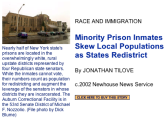Fixing prison-based gerrymandering after the 2010 Census: Colorado
50 State Guide, March 2010
- Sections
- Impact at the state level
- Impact at the local level
- Colorado law says a prison cell is not a residence
- Solutions
- Additional resources
Prison-based gerrymandering violates the constitutional principle of “One Person, One Vote.” The Supreme Court requires districts to be based on equal population in order to give each resident the same access to government. But a longstanding flaw in the Census counts incarcerated people as residents of the prison location, even though they can’t vote and aren’t a part of the surrounding community.
When legislators claim people incarcerated in their districts are legitimate constituents, they award people who live close to the prison more of a say in government than everybody else.
Impact at the state level:
- Denver County is home for 12% of Colorado, but more than 19% of the state’s prisoners are from Denver County. However, the state’s largest prisons are located outside the city in rural areas.
Impact at the local level:
The state requires counties to exclude the prison populations when drawing county districts. Otherwise, in Crowley County, the prison itself would be an entire district. As County Commissioner T.E. Allumbaugh said:
“It’s a bit of a joke. [The inmates] can’t vote. If they complain forever there’s a good chance I will never hear about it. There is a reason why they are in there, a reason why they don’t vote, a reason why they don’t pay taxes.”(source)
Colorado law says a prison cell is not a residence:
-
Colorado’s Constitution states unequivocally: “for the purpose of voting and eligibility to office, no person shall be deemed to have gained a residence… while confined in public prison.” (Colorado Constitution, Article VII, §4.)
And Colorado law requires counties to fix the Census Bureau’s prison miscount and draw fair districts based on actual population: “… the board of county commissioners shall change the boundaries of the commissioner districts… based on the most recent federal census of the United States minus the number of persons serving a sentence of detention or confinement in any correctional facility in the county.” (Colorado Revised Statutes §30-10-306.7(5)(a).)
Solutions:
- Ideally, the U.S. Census Bureau would change where it counts incarcerated people. They should be counted as residents of their home — not prison — addresses. There is no time for that in 2010, but Colorado should ask the Census Bureau for this change for 2020.
- The state should follow the lead of its counties and fix the Census Bureau’s prison miscount. For 2010, the state should, to the degree possible, count incarcerated people as residents of their home communities for redistricting purposes. Where that is not feasible, incarcerated people should be treated as providing unknown addresses instead of being used to pad the legislative districts that contain prisons.
Additional resources:
 Minority Prison Inmates Skew Local Populations as States Redistrict by Jonathan Tilove, Newhouse News Service, March 12, 2002
Minority Prison Inmates Skew Local Populations as States Redistrict by Jonathan Tilove, Newhouse News Service, March 12, 2002- A list of new large prisons built in Colorado since the 2000 Census. These prisons are likely to create new prison-based gerrymandering problems after their populations are counted in the 2010 census.
 Minority Prison Inmates Skew Local Populations as States Redistrict
Minority Prison Inmates Skew Local Populations as States Redistrict


